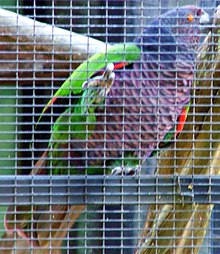Imperial Parrot
| Imperial Parrot | ||||||||||
|---|---|---|---|---|---|---|---|---|---|---|

Imperial Parrot ( Amazona imperialis ) |
||||||||||
| Systematics | ||||||||||
|
||||||||||
| Scientific name | ||||||||||
| Amazona imperialis | ||||||||||
| Richmond , 1899 |

The Imperial Amazon or Sisserou ( Amazona imperialis ) is a parrot of the subfamily of arini , which belongs to the Amazon bedrohtesten species.
description
With a body length of 45 centimeters, this Amazon species is considered the largest within the genus. The basic color of the plumage is green, but overall it is very colorful. The feathers on the forehead, crown and underside are colored wine-red with black edges. On the sides of the neck and in the nape of the neck, however, the feathers are dark purple, but also have black seams. The hand wings are dark brown, the tail feathers are dark red on the upper side and lighter towards the tail end.
Distribution area
The distribution area of the Imperial Amazon is limited to the island of Dominica in the Lesser Antilles . It is the country's national bird and appears on the flag and coat of arms of the island state . Their distribution area is inaccessible mountain forests at altitudes above 600 meters.
Way of life
The birds live in pairs or in small groups. The overnight places of a group of imperial amazons often remain in place for years. As a rule, the Imperial Parrot takes up food in the morning and evening. The birds are very calm while they are feeding. They mainly feed on fruits, berries, seeds, buds and flowers.
population
Large-scale habitat destruction, which led to a decline in habitats, fodder plants and suitable nesting holes, as well as the catch for trade meant that in 1975 only 150 to 250 Emperor Amazons lived. Hurricane David, which also had a dramatic effect on the populations of the blue-headed amazon , Puerto Rican amazon and king amazon , reduced the habitat of the imperial amazon again significantly in 1979. The population reached its lowest point in the 1980s with 50 animals. In contrast, the protective measures, the strict trade ban and an awareness campaign among the population of Dominica had a positive effect on the population. The authorities of Dominica estimated the population of this amazon species at a maximum of 200 specimens in 2019 - after the damage caused by Hurricane Maria 2017. It is still problematic that this colorful species achieves high prices in the black market.
swell
literature
- Thomas Arndt , Matthias Reinschmidt : Amazons , Volume 1: Free life, keeping, nutrition, breeding . Arndt-Verlag, Bretten 2006, ISBN 978-3-9808245-5-2 .
- Thomas Arndt, Matthias Reinschmidt: Amazons , Volume 2: Species, subspecies, special needs . Arndt-Verlag, Bretten 2009, ISBN 978-3-9808245-8-3 .
- Werner Lantermann : Amazon parrots. Biology, endangerment, keeping, species , Verlag Filander, Fürth 2007, ISBN 978-3-930831-66-1 .
- Werner Lantermann: Parrot studies: biology, ecology, species protection, behavior, keeping, species selection of parakeets and parrots . Verlag Parey, Berlin 1999, ISBN 3-8263-3174-5 .
- John Stoodley, Pat Stoodley: Genus Amazona . Bezels Publications, Lovedean 1990, ISBN 0-947756-02-7 .
Web links
- Amazona imperialis inthe IUCN 2013 Red List of Threatened Species . Listed by: BirdLife International, 2012. Retrieved September 26, 2013.
Individual evidence
- ↑ Lantermann (2007), p. 204.
- ↑ Lantermann (2007), p. 205.
- ↑ Ausgeflogen , Die Tageszeitung , February 11, 2019.